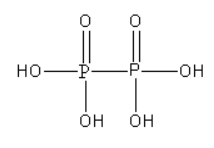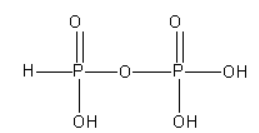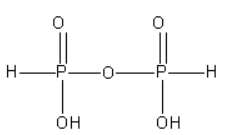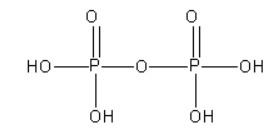
Answer
434.4k+ views
Hint:Draw the structure of all acids. Acid which does not contain \[{\text{ P - H}}\] bond is known as non-reducing acid. Use the oxidation number rules to determine the oxidation state of P atom.
Complete answer:
A. The structure of hypophosphoric acid (\[{{\text{H}}_{\text{4}}}{{\text{P}}_{\text{2}}}{{\text{O}}_{\text{6}}}\]) is as follows:

From the structure of hypophosphoric acid, we can say that there is a P-P bond present in it. However, there is no P-O-P bond in it.
As hypophosphoric acid does not contain \[{\text{ P - H}}\] bond it is known as non-reducing.
In hypophosphoric acid, both P atoms are surrounded by the same groups so we can determine the oxidation state P atom using the oxidation number rules.
According to the oxidation number rule, the oxidation state of oxygen is -2 and the oxidation state of hydrogen is +1.
In hypophosphoric acid, there are two P atoms, four H atoms and six O atoms.
(Number of P atoms) (Oxidation state of P) + (Number of O atoms) (Oxidation state of O) + (Number of H atom)(oxidation state of H atom)= 0
2 (Oxidation state of P) + 6(-2)+ 4(+1) = 0
Oxidation state of P = +4
Thus, Hypophosphoric acid (\[{{\text{H}}_{\text{4}}}{{\text{P}}_{\text{2}}}{{\text{O}}_{\text{6}}}\]) matches with 1, 2, 4 from list II.
Hence, for hypophosphoric acid A-1, 2, 4 is the correct answer.
B. The structure of Isohypophosphoric acid (\[{{\text{H}}_{\text{4}}}{{\text{P}}_{\text{2}}}{{\text{O}}_{\text{6}}}\]) is as follows:

From the structure of isohypophosphoric acid we can say that there is a P-O-P bond present in it. However, there is no P-P bond in it.
As isohypophosphoric acid contains the \[{\text{ P - H}}\] bond it is known as reducing.
Both P atoms are surrounded by different groups so the oxidation state of both P atoms is different.
The oxidation state of P atom bonded to H atom is +3 while the oxidation state of another P atom is +5.
Thus, isohypophosphoric acid (\[{{\text{H}}_{\text{4}}}{{\text{P}}_{\text{2}}}{{\text{O}}_{\text{6}}}\]) matches with 3,5 from list II.
Hence, for isohypophosphoric acid B-3,5 is the correct answer.
C. The structure of pyrophosphorous acid (\[{{\text{H}}_{\text{4}}}{{\text{P}}_{\text{2}}}{{\text{O}}_5}\]) is as follows:

From the structure of pyrophosphorous acid, we can say that there is a P-O-P bond present in it. However, there is no P-P bond in it.
As of pyrophosphorous acid contains the \[{\text{ P - H}}\] bond it is known as reducing.
In pyrophosphorous acid, both P atoms are surrounded by the same groups. The oxidation state of both P atoms is +3.
Thus, of pyrophosphorous acid (\[{{\text{H}}_{\text{4}}}{{\text{P}}_{\text{2}}}{{\text{O}}_5}\]) matches with 3,5 from list II.
Hence, for pyrophosphorous acid C-3,5 is the correct answer.
D. The structure of pyrophosphoric acid (\[{{\text{H}}_{\text{4}}}{{\text{P}}_{\text{2}}}{{\text{O}}_7}\]) is as follows:

From the structure of pyrophosphoric acid, we can say that there is a P-O-P bond present in it. However, there is no P-P bond in it.
As pyrophosphoric acid does not contain \[{\text{ P - H}}\] bond it is known as non-reducing.
In pyrophosphoric acid, both P atoms are surrounded by the same groups. The oxidation state of both P atoms is +5.
Thus, of pyrophosphoric acid (\[{{\text{H}}_{\text{4}}}{{\text{P}}_{\text{2}}}{{\text{O}}_7}\]) matches with 1,5 from list II.
Hence, for pyrophosphoric acid D-1,5 is the correct answer.
Thus, correct option is (a) A-1, 2, 4; B-3, 5; C-3, 5; D-1, 5
Note:
Acids are proton donor species. Proton bonded to the oxygen atom is known as an acidic proton. Proton bonded directly to the central atom is known as reducing proton.
Complete answer:
A. The structure of hypophosphoric acid (\[{{\text{H}}_{\text{4}}}{{\text{P}}_{\text{2}}}{{\text{O}}_{\text{6}}}\]) is as follows:

From the structure of hypophosphoric acid, we can say that there is a P-P bond present in it. However, there is no P-O-P bond in it.
As hypophosphoric acid does not contain \[{\text{ P - H}}\] bond it is known as non-reducing.
In hypophosphoric acid, both P atoms are surrounded by the same groups so we can determine the oxidation state P atom using the oxidation number rules.
According to the oxidation number rule, the oxidation state of oxygen is -2 and the oxidation state of hydrogen is +1.
In hypophosphoric acid, there are two P atoms, four H atoms and six O atoms.
(Number of P atoms) (Oxidation state of P) + (Number of O atoms) (Oxidation state of O) + (Number of H atom)(oxidation state of H atom)= 0
2 (Oxidation state of P) + 6(-2)+ 4(+1) = 0
Oxidation state of P = +4
Thus, Hypophosphoric acid (\[{{\text{H}}_{\text{4}}}{{\text{P}}_{\text{2}}}{{\text{O}}_{\text{6}}}\]) matches with 1, 2, 4 from list II.
Hence, for hypophosphoric acid A-1, 2, 4 is the correct answer.
B. The structure of Isohypophosphoric acid (\[{{\text{H}}_{\text{4}}}{{\text{P}}_{\text{2}}}{{\text{O}}_{\text{6}}}\]) is as follows:

From the structure of isohypophosphoric acid we can say that there is a P-O-P bond present in it. However, there is no P-P bond in it.
As isohypophosphoric acid contains the \[{\text{ P - H}}\] bond it is known as reducing.
Both P atoms are surrounded by different groups so the oxidation state of both P atoms is different.
The oxidation state of P atom bonded to H atom is +3 while the oxidation state of another P atom is +5.
Thus, isohypophosphoric acid (\[{{\text{H}}_{\text{4}}}{{\text{P}}_{\text{2}}}{{\text{O}}_{\text{6}}}\]) matches with 3,5 from list II.
Hence, for isohypophosphoric acid B-3,5 is the correct answer.
C. The structure of pyrophosphorous acid (\[{{\text{H}}_{\text{4}}}{{\text{P}}_{\text{2}}}{{\text{O}}_5}\]) is as follows:

From the structure of pyrophosphorous acid, we can say that there is a P-O-P bond present in it. However, there is no P-P bond in it.
As of pyrophosphorous acid contains the \[{\text{ P - H}}\] bond it is known as reducing.
In pyrophosphorous acid, both P atoms are surrounded by the same groups. The oxidation state of both P atoms is +3.
Thus, of pyrophosphorous acid (\[{{\text{H}}_{\text{4}}}{{\text{P}}_{\text{2}}}{{\text{O}}_5}\]) matches with 3,5 from list II.
Hence, for pyrophosphorous acid C-3,5 is the correct answer.
D. The structure of pyrophosphoric acid (\[{{\text{H}}_{\text{4}}}{{\text{P}}_{\text{2}}}{{\text{O}}_7}\]) is as follows:

From the structure of pyrophosphoric acid, we can say that there is a P-O-P bond present in it. However, there is no P-P bond in it.
As pyrophosphoric acid does not contain \[{\text{ P - H}}\] bond it is known as non-reducing.
In pyrophosphoric acid, both P atoms are surrounded by the same groups. The oxidation state of both P atoms is +5.
Thus, of pyrophosphoric acid (\[{{\text{H}}_{\text{4}}}{{\text{P}}_{\text{2}}}{{\text{O}}_7}\]) matches with 1,5 from list II.
Hence, for pyrophosphoric acid D-1,5 is the correct answer.
Thus, correct option is (a) A-1, 2, 4; B-3, 5; C-3, 5; D-1, 5
Note:
Acids are proton donor species. Proton bonded to the oxygen atom is known as an acidic proton. Proton bonded directly to the central atom is known as reducing proton.
Recently Updated Pages
Who among the following was the religious guru of class 7 social science CBSE

what is the correct chronological order of the following class 10 social science CBSE

Which of the following was not the actual cause for class 10 social science CBSE

Which of the following statements is not correct A class 10 social science CBSE

Which of the following leaders was not present in the class 10 social science CBSE

Garampani Sanctuary is located at A Diphu Assam B Gangtok class 10 social science CBSE

Trending doubts
Write the difference between order and molecularity class 11 maths CBSE

A rainbow has circular shape because A The earth is class 11 physics CBSE

Which are the Top 10 Largest Countries of the World?

Fill the blanks with the suitable prepositions 1 The class 9 english CBSE

How do you graph the function fx 4x class 9 maths CBSE

Give 10 examples for herbs , shrubs , climbers , creepers

What are noble gases Why are they also called inert class 11 chemistry CBSE

The Equation xxx + 2 is Satisfied when x is Equal to Class 10 Maths

Differentiate between calcination and roasting class 11 chemistry CBSE



